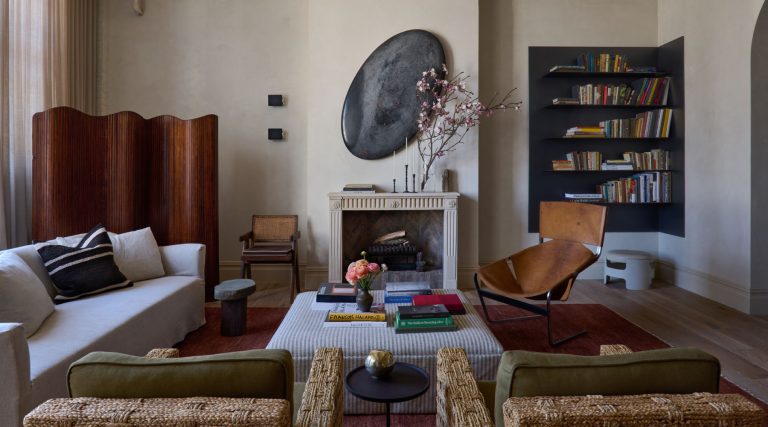
January 8, 2014A friendship that survived speed decorating: Client Kathleen Hughes (right) with decorator Kimba Hills of Rumba (photo courtesy of Kathleen Hughes). Top: A decisive decor (photo by Brett Beyer, courtesy of Rumba).
A question (or two): Is it possible for a profoundly indecisive person to suddenly become decisive and remodel a New York loft on a five-month deadline? And then furnish the loft tastefully — and on a budget — with one-of-a-kind furniture pieces in just seven days? Though it sounds like the makings of a reality show, this, in fact, was the challenge my husband and I faced after buying a loft in New York’s West Village as a future retirement spot. The board of our co-op building had given us the deadline when it approved our remodel, threatening a late penalty of $300 a day.
“I never reach a final decision on anything,” I warned Jeff Sherman, our architect at Delson or Sherman Architects, in Brooklyn, when he started to press for decisions. “Time usually just runs out.” That made him laugh. But it should have made him very nervous.
When we remodeled our ranch house in Rolling Hills, California, a decade ago, the process dragged on for almost five years as I waffled on everything from stone choices to lighting fixtures. Our designer on that project quietly gave up, becoming steadily less available.
I didn’t want to go through that again. A tendency to explore every last possibility can be useful in my career as a journalist, but not so much in the rest of life. (My son didn’t have a name for six months as I vacillated among William, Tyler and Daniel — Daniel ultimately won out.)

Clockwise from top: The New York loft’s master bedroom, kitchen and second bedroom, all pre-renovation. Photos by Kathleen Hughes

The gut renovation of the apartment was completed in just under five months. Photo by Kathleen Hughes
But with Jeff’s help (“Just give me three choices” became my go-to refrain), we completed the architectural renovations in under five months. No penalty. We loved the updated corner loft in a former printing plant from the early 1900s whose original maple floors and brick walls were intact. But we had no furniture.
“Let me help you,” said Kimba Hills, a friend and the owner of Rumba, in Santa Monica. In addition to selling mid-century furniture, she offers “SpeedDesign” services, meaning she will redo a home quickly, often in less than a month. But in my case, she was giving me just one week, the only time she had available.
I resolved that during our seven days together, I would furnish the entire loft, no matter what. If I didn’t see things I loved, I would pick the ones I liked the most. Or even just disliked the least. After the extensive renovations, I didn’t have a large budget left, but at the same time, I knew I only wanted unique pieces, nothing cookie-cutter.
Kimba devised our plan: We would quickly cover Manhattan and then take trains to Hudson, New York, and Stamford, Connecticut, to look for furniture. Thanks to a detour she had made after dropping her son off at Bard College, in Annandale-on-Hudson, she had discovered that both towns have treasure troves of reasonably priced antiques.
“A tendency to explore every last possibility can be useful in my career as a journalist, but not
so much in the rest of life.”

The author poses mid-construction with her husband, Dr. Daniel M. Bethencourt, son, Daniel, and daughter, Isabel. Photo courtesy of Kathleen Hughes
Day 1:

Part of the renovation entailed tearing up the 1970s oak floors to reveal the original, century-old maple strips underneath, which were restored and refinished. Photo by Kathleen Hughes
Manhattan. We started by searching for a couch at ABC Carpet & Home, where, confronted with thousands of swatches of upholstery fabrics, I felt the usual paralysis coming on like a migraine. I halted abruptly, saying I hated doing this. I was only one hour in.
Unfazed, Kimba suggested we head to Restoration Hardware, where she encouraged me to get a massive, eight-foot-long sofa in a simple, sand-colored linen. Yes, it was comfortable, and I liked it. But, still, I hesitated. “Trust me on this,” she said. “I know someone who worked with Michael Smith [who famously decorated the private quarters of the White House in 2008] and this is the couch he got the Obamas.”
Done.
Day 2:
We arrived in Hudson after a scenic, two-hour train ride and took a cab to Warren Street, home to dozens of antiques shops. (On the journey up, we scouted the street’s dealers on 1stdibs.)
Our first stop was Neven + Neven Moderne. In Kimba’s tow, I was beginning to learn the names of mid-century furniture designers: Russel Wright, Hans Wegner, Paul McCobb. Across the street at Arenskjold Antiques Art, we found a 10-foot-long Danish dining table and 12 chairs with faded green leather seats. It was one table in a sea of many. I liked several of the living room chairs, but Kimba kept reigning me in. “The scale is too small,” she said.
I persisted. I loved the two little green velvet Art Deco chairs. “No. They are going to look ridiculous with that couch,” she insisted firmly.

Warren Street in Hudson, New York, is home to a multitude of antiques shops. Photo by Kathleen Hughes
I began to text photos to friends and family, seeking other opinions. “Ehh. Not crazy about it,” texted my daughter, followed by an emphatic “No!” on an oval coffee table.
“Ditto!!! No way,” my husband added.
“Can’t we just get normal furniture?” wrote my daughter.
“Tell her no, because you’re not normal,” quipped Kimba.
Next door, at Regan & Smith Antiques, Kimba zeroed in on a honey-colored console table with metal legs by McCobb. “That’s perfect for the entryway,” she announced. I wasn’t so sure. I don’t like metal or glass on furniture. It seemed cold. But Kimba was certain, and so I surrendered.
Well, almost.
“I found your dining table!” Kimba exclaimed, practically dancing, as we made our way into Foley & Cox Home. Her enthusiasm bordered on contagious, but the table seemed too long and the color…too whitish gray. I resisted.
And then, finally, after pondering what seemed like every possible dining table on Warren Street, I finally gave in and made a decision: the Danish dining table and chairs at Arenskjold. Emboldened, I added two quirky Danish wingback chairs. The wooden wings reminded me of chairs from my childhood in Swarthmore, Pennsylvania.
“Boss,” my son texted, sealing the deal.
We still hadn’t found a desk or a coffee table so we kept walking. After heading into Warren Street Antiques, I spotted a set of Russel Wright end-tables in a corner and two wooden mid-century lamps. Up the street, at Sutter Antiques, Kimba and the owner fell into a long discussion. Alone, I noticed a modern desk with storage compartments and a top that folded out. I was getting better at spotting things and Kimba loved the desk.

Successful finds in Hudson included, from left, Danish wingback chairs at Arenskjold and a Paul McCobb console at Regan & Smith Antiques. Photos by Kathleen Hughes

Despite Hughes’ initial doubts, the McCobb console (newly topped with a slab of milk glass) looks right at home in the loft, paired with a McCobb mirror, a lamp from Rumba and a photograph by Cig Harvey from Robin Rice Gallery. Photo by Kathleen Hughes
Day 3:
After another train ride, this time to Stamford, we took a short cab ride to Hiden Galleries, a sprawling mass of antiques stalls that could easily intimidate the most decisive shopper. “Kathl-e-e-en, look what I found,” Kimba said in her sing-songy Tennessee accent.
She had spotted a brass Paul McCobb vertical mirror and was giddy, explaining it would work perfectly above the Paul McCobb console table we had purchased in Hudson.
“I don’t really like metal,” I said, hesitating. “Trust me on this,” Kimba said with her usual certainty. Done. Although I was still worried about the metal.
Day 4:
Back to Manhattan; a bust.
Day 5:
Kimba flew back to California but suggested I head to Kea Carpets and Kilims in Brooklyn. Alone. Oddly, I decisively loved seven of their antique rugs, mostly flat weaves in dark reds and blues.
But without Kimba, I needed another opinion. I began texting our architect. “It would be terrific,” Jeff replied after drawing the dimensions of a long narrow rug into our plans.
Day 6:
After flying back to California, I drove to the Palm Springs Modernism Show where Kimba had a booth. She had two bright orange Hans Wegner chairs on display. “These would be perfect in the loft,” she said. But they seemed too upright, too orange.
Still, I gave in — the key, I had learned, to moving quickly.

All together now: The Hans Wegner chairs and a coffee table that Hughes found at the Palm Springs Modernism Show complete the loft’s finished look. Photo by Brett Beyer, courtesy of Rumba
Day 7:

The revamped kitchen features floor-to-ceiling cabinets, soapstone counters and a zinc-top island. Photo by Brett Beyer, courtesy of Rumba
The deadline. Wandering around the show, I finally spotted a large coffee table, the last item on my list. It seemed the perfect one-of-a kind piece, sturdy and curved at both ends. Kimba dragged the orange chairs over and urged me to buy it on the spot.
Done. But I must confess to one additional bit of waffling on the wingbacks back in Hudson. “They aren’t my thing,” my friend Jane had texted. “Too Ozzie and Harriet.”
So I returned them to Arenskjold.
But then Jane looked at another photo, taken from a different angle, and decided that they could be “spectacular.” So I called the gallery and purchased the wingbacks a second time.
And with that, I had furnished the loft in seven days.
All the furniture arrived in time for my husband’s 60th birthday dinner. One guest, a Yale professor, pronounced the loft “spacious and elegant,” saying that “every detail seemed to evoke every other.”
I later asked Kimba just how difficult it was to work with me. “Your biggest problem is you ask too many people’s opinions,” she said with a sigh. “We were only as good as the last opinion you got.” The easiest people to work with, she added, are those who already know they aren’t good at this — and just want help from someone who does this all the time.
“We’re not all good at everything,” she said.
I know that to be true — no second opinion required.


